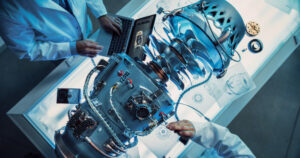
In Pennsylvania, extrude hone machining is used to smooth and polish a wide range of parts. Extrude hone machining is a finishing process that removes burrs and surface roughness from parts made of metal, plastic, ceramics, and other materials. It provides many benefits over other finishing methods, such as consistent and repeatable results and the ability to smooth and polish parts with intricate geometries and complex inner surfaces.
During the extrude hone process, a specially formulated and mixed extrude hone media is used to remove burrs and other surface imperfections. The media is extruded along the inner and outer surfaces of a workpiece. Abrasive materials in the extrude hone media erode unwanted material while smoothing and polishing a workpiece.
You Need the Right Extrude Hone Media to Get the Desired Results
The most important part of the extrude hone finishing process is the selection of the right extrude hone media for a particular job. The effectiveness of extrude hone media depends on several factors. Careful consideration of these factors when formulating and mixing the extrude hone media is essential for achieving desired results. These factors include:
- Abrasive Type: The choice of abrasive depends on the material being processed and the desired surface finish. Aluminum oxide, CBN, and silicon carbide are three types of abrasives commonly used in extrude hone media.
- Abrasive Particle Size: The size of the abrasive particles used in extrude hone media significantly affects its finishing characteristics. Smaller particles may result in a finer finish, while larger particles can more aggressively remove burrs and surface roughness.
- Abrasive Particle Density: The density of abrasive particles within the extrude hone media is crucial for uniform material removal. Higher densities generally remove more material but may also result in a rougher finish. Finding the right balance of particle density is crucial.
- Viscosity: A critical property of extrude hone media, viscosity influences how well the abrasive particles are suspended and transported within the carrier medium. Viscosity can be optimized for the specific application and the equipment used.
- Carrier Medium: A carrier medium is used to suspend the abrasive particles in the extrude hone media. It has a big impact on the viscosity of the abrasive flow media. The choice of carrier medium depends on factors like viscosity requirements and chemical compatibility with the workpiece material.
- Workpiece Material: The abrasive materials used for extrude hone media must be suited for use with the workpiece material. If the abrasive materials are too soft, it may not be able to effectively remove surface imperfections from the workpiece. If the abrasive material is too hard, it could damage the workpiece.
Other considerations include pressure and flow rates, equipment design, chemical compatibility, safety considerations, and temperature.
Deburring & Finishing Technologies Deliver the Right Extrude Hone Media for Any Job
When companies in Pennsylvania need precisely formulated and mixed extrude hone media, they turn to Deburring & Finishing Technologies. We’ve been a leading provider of extrude honing media to companies in Pittsburgh and the entire state of Pennsylvania since 2009. Our team of engineers has the experience and equipment to create extrude hone media precisely suited for your particular job.
You can get in touch with Deburring & Finishing Technologies through our website or call us at (412) 849-1522 to discuss your extrude hone media needs and receive a free quote.
